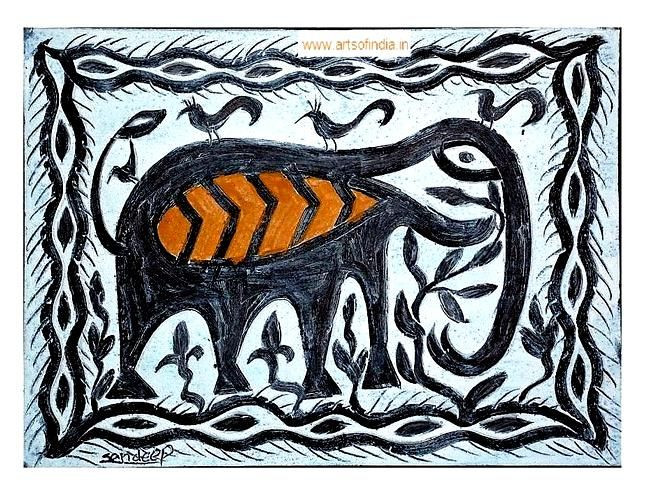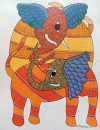In the tribal villages of Hazaribagh and its adjoining districts in the Indian state of Jharkhand, the mud homes of Adivasi(native) people are adorned with bold figurative murals which are known as Khovar and Sohrai paintings. Khovar paintings mostly done in black and white at the tribal marriage chamber, are considered auspicious and said to bring good luck to newlyweds. 'Koh' meaning a cave and 'var' meaning husband, make up the word Khovar. Symbolizing fertility, the mural-making of Khovar takes place each spring, heralding the marriage season in tribal society.
History of Khovar Paintings
A dozen of Mesolithic rock- art sites in this area indicate a lengthy continuity of mural art in and around the district of Hazaribagh. Khovar wall painting is an age-old tradition of decorating the marriage chamber of the bride and groom. The themes are drawn from the interaction of artists with nature. The forest-dwelling tribals mostly sketch tigers, deer, elephants, peacocks, and snakes. The agro-based tribals show domestic animal forms like the cow, bull, goat, fowl, pigeon, peacock. The Khovar designs are painted by the mother of the bride and other women of the village as part of their matrimonial rituals at the place of the marriage ceremony and where the new couple would sleep. The skills and motifs to create murals are passed on from mother to daughter down the countless generations.
Techniques and Materials Used
The colors used are taken from nature, the manganese black and white soil (dudhi mitti) is locally sourced. The base coat is usually black and the top layer of white is applied over the mud wall. The Khovar murals are painted by tribal women usually the mother-in-law and sister-in-law duo using different techniques such as scrapping using four fingers, with broken pieces of combs, with twigs and clothes, swabs, and stencils. The black figures and motifs are etched over the white base.
Now the practice of Khovar painting on handmade papers and canvases is done, so that it may be sold to patrons. The commercial sale of khovar painting not only keeps the tribal art alive but also makes the women artists economically empowered.
Challenges Faced by the Tribal People
When the painted villages were discovered, it was a challenge to get these paintings onto a canvas, so that they could be exhibited. The first step was getting the visitors there to tell these stories to the outside world. Initially, it was done through Tribal Women Artist's Cooperative, TWAC, founded by the tribal art enthusiasts, Padmasree awardee Bulu Imam in 1995.
The next big challenge was to translate the huge paintings onto handmade papers and canvases. The manganese black (Kali mitti) and white soil (dudhi mitti ) are collected from local mines. The lump of colors was first powdered and then mixed with water and glue and applied on the canvas or handmade papers.
Artiste of Contemporary Culture
The tribal art of Khovar paintings was first brought to light and popularized by the efforts of Bulu Imam. To support the tribal women's creative pursuit, he became the convener of Tribal Women Artist's Cooperative(TWAC) in 1995.
The tribal women of the Hazaribagh region of Jharkhand are now supported and encouraged by the NGOs and other Government organizations to keep the art of mural paintings of Khovar alive and thriving.
Current Scenario
The sustained efforts are to preserve the wall art and to keep traditional tribal art flourishing. In recent years though the Khovar Painting seems to be vanishing in the villages since mud walls are being replaced by brick cement plaster. Also, young girls are reluctant to undertake the strenuous work of painting alongside their studies.
Increasing migration, displacement of agricultural settlements because of mining activities, and large thermal power projects have become major impediments in keeping the mural art alive.
On 15 May 2020, the GI(Geographic Indication) tag was awarded by the Central Government to Sohrai- Khovar mural paintings of Jharkhand.
The public places in Jharkhand like Birsa Munda Airport, Ranchi, Hazaribagh, and Tatanagar Railway station among others have been decorated with Sohrai- Khovar paintings. The Jharkhand Government had also announced to adorn the trains and government housing with Sohrai-Khovar paintings to promote the tribal art of the region.
The paintings are exhibited and sold from various exhibitions and online platforms ARTS of INDIA is such a platform that also sells and promotes Khovar art and paintings. Sarees and home decor, a variety of attires, fashion accessories and face masks illustrating Khovar art of tribal paintings are also available.
To prevent the Khovar paintings from going into oblivion, a concerted effort is needed from the government, industrialists, and art enthusiasts. They all must jointly work to make the tribal artists economically self-sufficient so that these women could concentrate on expressing their art on canvases. It should be also ensured that the Khovar paintings get the proper exposure and reached art lovers around the world.
Picture Source: ARTS of INDIA



